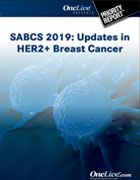Publication
Article
Priority Report
Piccart Highlights 6-Year Follow-Up With Adjuvant Pertuzumab Regimen in HER2+ Breast Cancer
Author(s):
Martine J. Piccart, MD, PhD, discusses the 6-year follow-up of the APHINITY trial and its impact on the breast cancer field.
Martine J. Piccart, MD, PhD, professor of oncology at the Universite Libre de Bruxelles and the director of the Department of Medicine at Jules Bordet Institute,

Martine J. Piccart, MD, PhD
The 6-year follow-up results of the phase III APHINITY trial expressed continued benefit for adding adjuvant pertuzumab (Perjeta) to trastuzumab (Herceptin) and chemotherapy in patients with HER2-positive early breast cancer, explained Martine J. Piccart, MD, PhD.
The APHINITY trial (NCT01358877) examined the adjuvant combination of pertuzumab with trastuzumab plus chemotherapy. Longer follow-up data presented at the 2019 San Antonio Breast Cancer Symposium (SABCS) showed a 0.9% absolute improvement in overall survival (OS) rate and also reduced the risk of invasive disease recurrence in patients with HER2-positive early breast cancer.
The OS rate was 94.8% in the pertuzumab arm compared with 93.9% in the placebo arm, leading to a 15% reduction in the risk of death; however, this was not found to be statistically significant as per a predetermined P value of .0012 (HR, 0.85; 95% CI, 0.67-1.07; P = .170). However, the survival data are still immature, according to Piccart.
Earlier data from the APHINITY trial, which showed an invasive disease-free survival (iDFS) benefit with the addition of adjuvant pertuzumab, led to the December 2017 FDA approval of pertuzumab in combination with trastuzumab and chemotherapy as an adjuvant treatment for patients with HER2-positive early breast cancer at high risk for recurrence. Researchers are in the process of identifying biomarkers beyond nodal status that will predict which patients will benefit from receiving this regimen.
“Dual HER2 blockade plus chemotherapy is the preferred option in early HER2-positive breast cancer for women at high risk,” said Piccart. “It is not an option right now for women with node-negative disease because we have not seen any treatment effect there. However, we are working hard at finding biomarkers beyond nodal status. We hope to build a risk score that will be based on not only nodal status, but tumor size, age, hormone receptor status, tumor-infiltrating lymphocytes, and number of HER2 gene copies.”
“We want to integrate all of these factors to define a risk,” Piccart added. “Then, we can perform a step analysis. For a certain risk, we can see whether the 2 curves are superimposable or if they are diverging. With this type of analysis, we hope to have a better way of identifying patients who might clearly benefit from pertuzumab.”
In an interview with OncLive during the 2019 SABCS, Piccart, professor of oncology at the Université Libre de Bruxelles and the director of the Department of Medicine at Jules Bordet Institute, discussed the 6-year follow-up of the APHINITY trial and its impact on the breast cancer field.
OncLive: Could you provide an overview of the APHINITY trial?
Piccart: We are very happy about the 6-year results of the APHINITY trial. We can say that the clinical benefit of pertuzumab has been observed in patients with early HER2-positive breast cancer and node-positive disease. We now have an estimated absolute benefit at 6 years at 4.5% for the rate of iDFS. At this second interval analysis of OS that we performed, [these data are] still quite immature. We will continue to follow up.
We have not seen new cardiac safety issues, meaning we have a favorable clinical benefit versus harm ratio because the incidence of severe cardiac events with the addition of pertuzumab to standard chemotherapy and trastuzumab is 0.8% versus 0.3% [without pertuzumab].
Another interesting observation is now we can see that the benefit of pertuzumab is independent of the hormone receptor status. When we did the primary analysis 2.5 years ago with a shorter median follow-up, we had the impression that the benefit was confined to the group of women with hormone receptor—negative, HER2-positive disease. Now, we can clearly see a benefit emerging in the hormone receptor–positive population, and that’s probably because events in this population accumulate more slowly over time. We see a little divergence between the curves. Now, at 6 years, the absolute benefit in those with hormone receptor–positive disease is very clear, at about 3%, and that has important clinical implications.
How are the updated data expected to affect clinical practice?
There is a progressive shift from adjuvant treatment to neoadjuvant treatment for all women who have intermediate- or high-risk tumors. The fact is that, in many places around the world, neoadjuvant treatment is not the preferred [approach]; it requires very close collaboration among surgeons, medical oncologists, radiotherapists, radiologists, and pathologists. In many places, adjuvant treatment is still preferred. Hopefully, the APHINITY trial will give women at high risk a better chance to be cured of this disease, because it is an adjuvant trial. The goal, of course, is to cure more patients.
Can any biomarkers be used to choose patients for this treatment?
Last year, we presented a biomarker exploratory analysis of about 1000 patients; one-fourth of those patients had relapsed. Each of the patients who relapsed were matched to those [who did not] relapse. We collected all the tumors, did DNA sequencing and RNA sequencing, evaluated the tumor-infiltrating lymphocytes (TILs), and looked at the HER2 gene copy number.
To make a long story short, there were, at that time, 2 biomarkers that seemed to be linked with the benefit of pertuzumab. We found biomarkers that indicated poor prognosis, but we need biomarkers telling us who needs pertuzumab. The 2 [biomarkers] at that time were TILs and HER2 gene copy number. Now, we will have to update this analysis, because we have [identified] more events. Clearly, the biomarker research will be more productive with a longer follow-up.
At this point in time, with the data that we have, the only biomarker that is indicative of a potential benefit of pertuzumab is nodal positivity. Any patient presenting with node-positive disease should be considered for the addition of pertuzumab with a discussion about potential benefits and risk. Hopefully, [in the future], we will be able to do better than that.
What is the safety profile of this regimen?
I have been focusing on cardiac events because these are potentially irreversible, severe adverse events (AEs) from the treatment. A more frequent AE [that is associated with the addition of] pertuzumab to chemotherapy and trastuzumab is diarrhea. Pertuzumab is associated with more diarrhea and with more grade 3 diarrhea, with an incidence of about 10%.
In a curative setting, women will not be too bothered by that. The diarrhea can be controlled, and it is mainly seen when pertuzumab is added to chemotherapy. When the chemotherapy is finished and [treatment] continues with just trastuzumab and pertuzumab, the diarrhea goes away very quickly. It is important to inform patients about that; in talking to them about curative treatments, they want to be mostly aware of the potential irreversible severe AEs. What is transient is less important because they want to get rid of the disease.
What are the next steps of this research?
We need to continue to follow up on our patients. We have a definitive OS analysis that is event-driven and is based on 640 deaths. That is planned and will happen a few years from now; it's going to be important because if we can show a survival benefit, the data become even stronger.
However, I am personally thinking that living without a recurrence, even if your OS is not prolonged, is very important for women. We need to remember that in HER2-positive disease, [patients are] about 10 years younger than [those with] luminal breast cancer. The median age [for HER2-positive breast cancer] is 49. [These patients] are still professionally active and might still have to raise kids. It’s very important to be able to live without the disease and without treatment for several years.
Longer follow-up, repeating the biomarker analysis on more tumor samples with more events, and developing a step analysis that might introduce a composite risk [is necessary]; it can indicate to the physician, with all these parameters integrated, who might benefit from these more expensive treatments.
What does the future treatment of these patients look like?
In Europe in a clinical trial, we plan to closely evaluate a new formulation of pertuzumab and trastuzumab combined as a single subcutaneous injection. We believe that in the future, this could allow women to self-administer the subcutaneous injection at home. That would be fantastic because as soon as the chemotherapy is over, they would not need to come every 3 weeks to the hospital anymore.
Piccart M, Procter M, Fumagalli D, et al. Interim overall survival analysis of APHINITY (BIG 4-11): a randomised multicenter, double-blind, placebo-controlled trial comparing chemotherapy plus trastuzumab plus pertuzumab versus chemotherapy plus trastuzumab plus placebo as adjuvant therapy in patients with operable HER2-positive early breast cancer. Presented at: 2019 San Antonio Breast Cancer Symposium; December 10-14, 2019; San Antonio, TX. Abstract GS1-04.










